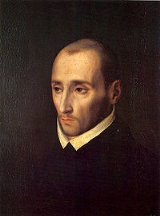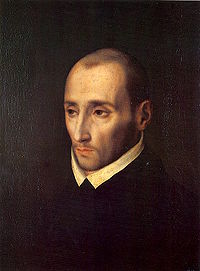
Juan de Ribera
Encyclopedia

Seville
Seville is the artistic, historic, cultural, and financial capital of southern Spain. It is the capital of the autonomous community of Andalusia and of the province of Seville. It is situated on the plain of the River Guadalquivir, with an average elevation of above sea level...
, Spain, on March 20, 1532, and died in Valencia on January 6, 1611. Ribera was one of the most influential figures of his times, holding appointments as Archbishop and Viceroy of Valencia, patriarch of Antioch
Antioch
Antioch on the Orontes was an ancient city on the eastern side of the Orontes River. It is near the modern city of Antakya, Turkey.Founded near the end of the 4th century BC by Seleucus I Nicator, one of Alexander the Great's generals, Antioch eventually rivaled Alexandria as the chief city of the...
, Commander in Chief, president of the Audiencia, and Chancellor of the University of Valencia. He was beatified in 1796 and canonized by Pope John XXIII
Pope John XXIII
-Papal election:Following the death of Pope Pius XII in 1958, Roncalli was elected Pope, to his great surprise. He had even arrived in the Vatican with a return train ticket to Venice. Many had considered Giovanni Battista Montini, Archbishop of Milan, a possible candidate, but, although archbishop...
in 1960.
Biography
His father was Pedro de RiberaPedro de Ribera
Pedro de Ribera was a Spanish architect of the Baroque period.-Biography:Ribera worked almost exclusively in Madrid during the first half of the 18th century. He was a disciple of José Benito de Churriguera...
, Viceroy of Naples
Naples
Naples is a city in Southern Italy, situated on the country's west coast by the Gulf of Naples. Lying between two notable volcanic regions, Mount Vesuvius and the Phlegraean Fields, it is the capital of the region of Campania and of the province of Naples...
and Duke of Alcala. He became an orphan from mother's side at a very young age.
Juan de Ribera studied at the University of Salamanca
University of Salamanca
The University of Salamanca is a Spanish higher education institution, located in the town of Salamanca, west of Madrid. It was founded in 1134 and given the Royal charter of foundation by King Alfonso IX in 1218. It is the oldest founded university in Spain and the third oldest European...
. Ordained as priest in 1557, Pope Pius IV appointed him Bishop of Badajoz on May 27, 1562, at the age of 30. There he dedicated himself to teaching the catechism
Catechism
A catechism , i.e. to indoctrinate) is a summary or exposition of doctrine, traditionally used in Christian religious teaching from New Testament times to the present...
to Roman Catholics and counteracting Protestantism
Protestantism
Protestantism is one of the three major groupings within Christianity. It is a movement that began in Germany in the early 16th century as a reaction against medieval Roman Catholic doctrines and practices, especially in regards to salvation, justification, and ecclesiology.The doctrines of the...
. He was appointed as the Archbishop of Valencia
Archdiocese of Valencia
The Archdiocese of Valencia is a Catholic ecclesiastical territory located in north-eastern Spain, in the province of Valencia, part of the autonomous community of Valencia. The archdiocese heads the ecclesiastical province of Valencia, having Metropolitan authority over the suffragan dioceses of...
on December 3, 1568. King Philip III of Spain
Philip III of Spain
Philip III , also known as Philip the Pious, was the King of Spain and King of Portugal and the Algarves, where he ruled as Philip II , from 1598 until his death...
later appointed him Viceroy of Valencia in 1602, and thus he became both the religious and the civil authority. In this role he founded the Museum of the Patriarch, known among Valencians as College of Saint John, entrusted to the formation of priests according to the spirit and the dispositions of the Council of Trent
Council of Trent
The Council of Trent was the 16th-century Ecumenical Council of the Roman Catholic Church. It is considered to be one of the Church's most important councils. It convened in Trent between December 13, 1545, and December 4, 1563 in twenty-five sessions for three periods...
.
Expulsion of the Moriscos
As Archbishop, Ribera dealt with the issue of Valencia's large moriscoMorisco
Moriscos or Mouriscos , meaning "Moorish", were the converted Christian inhabitants of Spain and Portugal of Muslim heritage. Over time the term was used in a pejorative sense applied to those nominal Catholics who were suspected of secretly practicing Islam.-Demographics:By the beginning of the...
population, descendants of Muslims who converted to Christianity at threat of exile. The moriscos had been kept separate from the main population by a variety of decrees that prohibited them from holding public office, entering the priesthood, or taking certain other positions; as a result, the moriscos had maintained their own culture rather than assimilated. Some of them did, in fact, still practice forms of crypto-Islam.
Ribera despised the moriscos as heretics and traitors, a dislike he shared with much of Valencia's Christian populace. With the Duke of Lerma, Ribera helped convince Philip III to at least expel the moriscos instead. Ribera helped sell the plan by noting that all the property of the moriscos could be impounded to provide money for the treasury. In 1609, the expulsion of the moriscos
Expulsion of the Moriscos
On April 9, 1609, King Philip III of Spain decreed the Expulsion of the Moriscos . The Moriscos were the descendants of the Muslim population that converted to Christianity under threat of exile from Ferdinand and Isabella in 1502...
from Spain was decreed. Ribera's original proposal was in fact more extreme: he favored enslaving
Slavery
Slavery is a system under which people are treated as property to be bought and sold, and are forced to work. Slaves can be held against their will from the time of their capture, purchase or birth, and deprived of the right to leave, to refuse to work, or to demand compensation...
the entire morisco population for work in galleys, mines, and abroad
Slavery in the Spanish New World colonies
Slavery in the Spanish colonies began with the enslavement of the local indigenous peoples in their homelands by Spanish settlers. Enslavement and production quotas were used to force the local labor to bring a return on the expedition and colonization investments...
. Ribera said that Philip III could do so "without any scruples of conscience," but this proposal was rejected. If the moriscos were to be expelled, Ribera favored enslaving and Christianizing at least the children of the moriscos "for the good of their souls" and exiling the parents. This was also rejected, though children under 16 years of age who wished to remain in Spain were allowed, an offer very few took.
Canonization
Efforts to canonize Ribera, who himself had been active in attempting to canonize Ignatius of LoyolaIgnatius of Loyola
Ignatius of Loyola was a Spanish knight from a Basque noble family, hermit, priest since 1537, and theologian, who founded the Society of Jesus and was its first Superior General. Ignatius emerged as a religious leader during the Counter-Reformation...
, began shortly after his death. Two concerns were raised about his possible sainthood: his failure to hold a provincial council as mandated by the Council of Trent
Council of Trent
The Council of Trent was the 16th-century Ecumenical Council of the Roman Catholic Church. It is considered to be one of the Church's most important councils. It convened in Trent between December 13, 1545, and December 4, 1563 in twenty-five sessions for three periods...
, and his role in the expulsion of the Moriscos
Expulsion of the Moriscos
On April 9, 1609, King Philip III of Spain decreed the Expulsion of the Moriscos . The Moriscos were the descendants of the Muslim population that converted to Christianity under threat of exile from Ferdinand and Isabella in 1502...
. His supporters played up Ribera's adherence to other parts of the Council of Trent, and tried to present the Moriscos as unconvertible ("[His conversion attempts] had no more effect on the moriscos as if they had been stones"). Still, efforts proceeded apace, with various admiring biographies (vidas) of Ribera being published. Ribera was beatified in 1796. In 1960, his canonization was completed under the auspices of Pope John XXIII
Pope John XXIII
-Papal election:Following the death of Pope Pius XII in 1958, Roncalli was elected Pope, to his great surprise. He had even arrived in the Vatican with a return train ticket to Venice. Many had considered Giovanni Battista Montini, Archbishop of Milan, a possible candidate, but, although archbishop...
.

